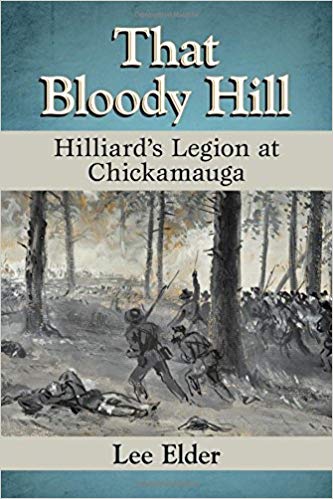That Bloody Hill: Hilliard’s Legion at Chickamauga by Lee Elder. McFarland and Company, 2017. Paper, IBSN: 978-1476669588. $35.00.
 With That Bloody Hill: Hilliard’s Legion at Chickamauga, author Lee Elder brings one of the most dramatic stories of the battle of Chickamauga—the assault of Brigadier General Archibald Gracie’s brigade against Snodgrass Hill on the battle’s final day—to the forefront in vivid detail. In many ways, this action can be viewed as representative of the attacks all along the Horseshoe Ridge line on the afternoon of September 20, 1863.
With That Bloody Hill: Hilliard’s Legion at Chickamauga, author Lee Elder brings one of the most dramatic stories of the battle of Chickamauga—the assault of Brigadier General Archibald Gracie’s brigade against Snodgrass Hill on the battle’s final day—to the forefront in vivid detail. In many ways, this action can be viewed as representative of the attacks all along the Horseshoe Ridge line on the afternoon of September 20, 1863.
Gracie’s assault has special meaning to Elder, as he had several ancestors serving in the brigade as members of Hilliard’s Legion from Alabama. Having explored the area extensively, Elder dived into researching not only what happened there, but who these men were. The result is this book, which not only tells the story of the fight at Chickamauga, but relates the journey that brought them there.
Elder’s narrative begins with the formation of the unit in 1862, when Henry Washington Hilliard, a noted Alabama politician and man of prominence, received a colonel’s commission and was authorized to raise a legion. A legion was a unique style of unit that included a battalion of artillery, a battalion of cavalry, and several battalions of infantry all serving together.
After Hillard’s Legion formed, it left Alabama to occupy East Tennessee and the all important Cumberland Gap. Its first casualties were suffered not on the battlefield, but in camp. By late 1862 the concept of the legion was officially abandoned, being too cumbersome to properly command. The cavalry battalion was merged with a Georgia unit to become the 10th Confederate Cavalry regiment. The infantry battalions, meanwhile, were re-designated as the 1st, 2nd, and 3rd Alabama Battalions, and with the exception of one company, the artillery became the 4th Alabama Battalion.
His legion dissolved, Hilliard resigned in December; however, the men of the infantry battalions would continue to call themselves Hilliard’s Legion. What remained of the legion’s battalions continued their service in East Tennessee and southeastern Kentucky, becoming part of Brigadier General Archibald Gracie III’s brigade. In the summer of 1863, they would finally be transferred to the seat of action in Tennessee, becoming part of the Army of Tennessee as it faced off against the United States Army of the Cumberland in the struggle for Chattanooga.
As part of General William Preston’s Division of General Simon Bolivar Buckner’s Corps, they would finally see combat on the third and final day at Chickamauga. The fighting at Chickamauga had been what one Union general called, “bushwhacking on a grand scale.” But the fight finally coalesced along the slopes of Horseshoe Ridge, where Union forces rallied and mounted a stout defense against growing Confederate pressure.
Here Elder’s story of the units of Hilliard’s Legion comes alive, using various voices from soldiers’ letters and diary accounts to tell the tale. In one of the final attacks upon the Union positions, just above the Snodgrass family farm, portions of the command broke the Union lines and make a lodgment. They captured the top of what is today called Hill Number One before being compelled to retire, having expended all of their ammunition. With the Alabamians’ withdrawal, Union forces reoccupied the area as dusk settled over the field; orders then arrived for them to withdraw as the fighting finally died down. Gracie’s men would occupy the top of the hill once again without opposition, ending their first battle. The cost of these few hours of fighting for the members of the legion were severe. Company F of the 1st Battalion, for example, reported losing 18 of the 26 men it carried into the fight. It was a grim first outing for the Alabamians.
Though the book focuses on the units of Hilliard’s Legion at Chickamauga, Elder does include a final chapter discussing what happened after the battle. Ultimately, the battalions ended up in the Army of Northern Virginia; they were once again re-designated and consolidated into two regiments, finishing the war in the Petersburg trenches.
Elder rounds out the book with ten appendixes and a roster of the unit. Overall, this is a good read about an important part of the battle of Chickamauga, written in a lively style. I recommend this book for anyone interested in the unit or Chickamauga in general; it is a timely addition to the growing historiography of the battle.
William Lee White is the author of Bushwhacking on a Grand Scale and a contributor to the Emerging Civil War blog.
